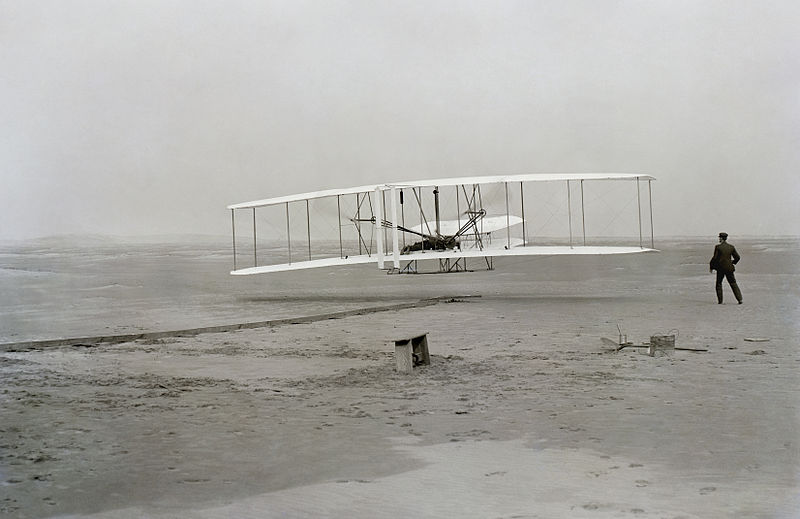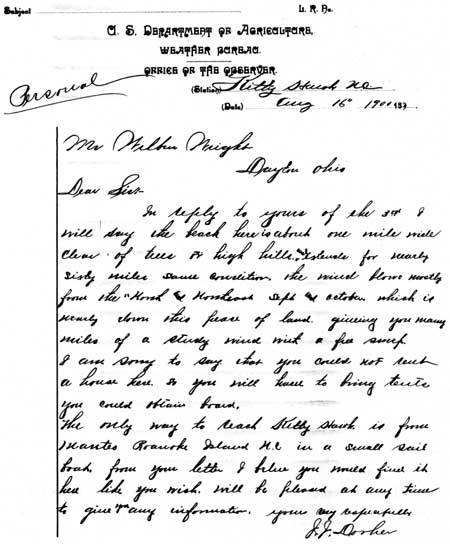December 17, 2013 - 110th Anniversary of the Wright Brothers' First Flight
On December 17, 1903, Wilbur and Orville Wright made four brief flights at Kitty Hawk, North Carolina with their first powered aircraft. From 1905 to 1907, the Wright Brothers developed their flying machine into the first practical fixed-wing aircraft. Although not the first to build and fly experimental aircraft, the Wright Brothers were the first to invent aircraft controls that made fixed-wing powered flight possible. The initial flight lasted 12 seconds and covered 120 feet. Three more flights were made that day with Wilbur Wright piloting the record flight lasting 59 seconds over a distance of 852 feet. Previously, in 1900, The Wright Brothers had journeyed to Kitty Hawk to begin their manned gliding experiments, as the mid-Atlantic coast was known for its regular breezes and soft sandy landing surfaces.
The National Weather Service, then known as the U.S. Weather Bureau, played an important role in this First Flight. The first Weather Bureau Station in North Carolina was established by the Signal Corps, US Army on August 16, 1874 at the Cape Hatteras Lighthouse keeper's quarter as a weather reporting station and commercial telegraph office. A second Weather Office was set up at the Kitty Hawk Life Saving Station from January 2, 1875 to 1904. It was established for the purpose of facilitating the repair of the telegraph line connecting Cape Hatteras and Cape Henry. In determining the best location to test their flying machine, the Wright Brothers wrote to the Weather Bureau office in Kitty Hawk, which seemed like a good candidate for the test flight. They received a prompt and friendly reply from Joseph J Dosher, who staffed the Weather Bureau office, which helped to convince them that Kitty Hawk was the best place to attempt their feat.

The Wright Brothers conduct the First flight, December 17, 1903, at Kitty Hawk, NC.
Here is the response from Dosher to the Wright Brothers, written in August of 1900 regarding the suitability of Kitty Hawk as test location for their first flight attempt, with the authentic letter obtained from the National Park Service website on the left.
 |
Mr Wilbur Wright
Dayton Ohio Dear Sir, In reply to yours of the 3rd, I will say the beach here is about one mile wide clear of trees or high hills, and islands for nearly sixty miles south. Conditions: the wind blows mostly from the North and Northeast September and October which is nearly down this piece of land. Giving you many miles of a steady wind with a free sweep. I am sorry to say that you could not rent a house here. So you will have to bring tents. You could obtain board. The only way to reach Kitty Hawk is from Manteo Roanoke Island N.C. in a small sail boat. From your letter I believe you would find it here like you wish. Will be pleased at any time to give you any information. Yours very respectfully
JJ. Dosher |
Dosher maintained a good relationship with the Wright Brothers during their years of testing. In fact, the telegraph which alerted the world to the historic first flight came from the Weather Bureau. Orville walked to the Kitty Hawk Weather Office late in the afternoon of December 17, 1903 and sent a telegraph to his father detailing the successes of the day.

Telegraph sent from the Weather Bureau Office in Kitty Hawk by Orville Wright, telling father about the successful flights of Dec. 17, 1903. (Obtained from National Park Service Website).
In October 1911, Orville Wright returned to the Outer Banks again, to improve the aircraft and conduct tests for safety and stabilization with a new glider. On October 24, he soared for nine minutes and 45 seconds, a record that held for almost 10 years, when gliding as a sport began in the 1920s.

Wilbur Wright flies a glider in earlier tests Kitty Hawk, Oct. 10, 1902.
On Dec. 1, 1918, the U.S. Weather Bureau issued its first aviation weather forecast. It was for the Aerial Mail Service route from New York to Chicago. On May 20, 1926, Congress passed the Air Commerce Act, which included legislation directing the Weather Bureau to "furnish weather reports, forecasts, warnings, to promote the safety and efficiency of air navigation in the United States. The National Weather Service continues its support of the aviation industry today. National Weather Service Forecast Offices issue almost 2,500 routine and amended aviation weather forecasts for 537 airports around the nation daily. National Weather Service aviation forecasts help mitigate air traffic delays, and reduce weather-related aviation accidents.
The National Weather Service is currently moving towards enhanced digital aviation services. The goal moving forward with this initiative is to provide high-quality, and consistent forecasts by having the Terminal Aerodrome Forecasts (TAFs) derived directly from the gridded forecast database. New hourly graphical aviation elements, ceiling and visibility, will be added to the NDFD database and will be available to users. This is a new way of thinking about aviation forecasting, going from a point forecast to an aerial forecast. The NWS Newport/Morehead City is currently working towards enhanced digital aviation services at our local office.